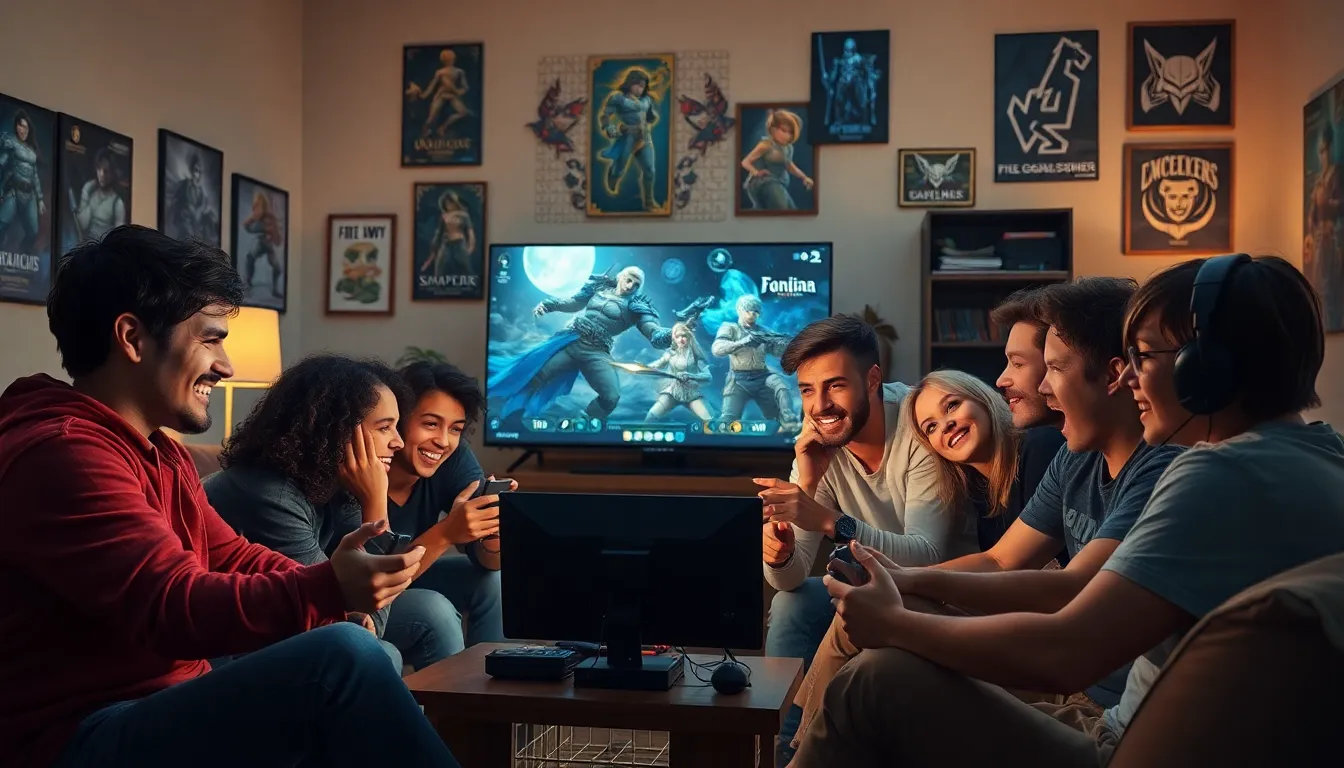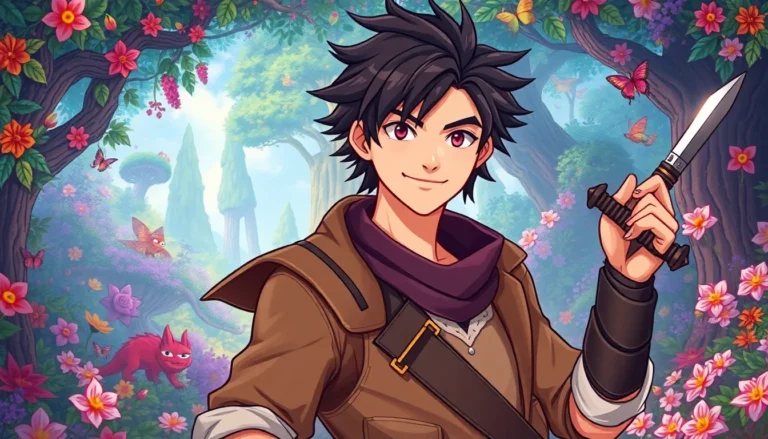In a world where dragons roam and dungeons await, multiplayer RPGs are the ultimate playground for adventurers. Imagine teaming up with friends or strangers to slay beasts, conquer quests, and maybe even steal a few virtual snacks along the way. These games aren’t just about leveling up; they’re about forging friendships and creating epic stories that’ll make even your cat jealous.
Whether you’re a seasoned warrior or a newbie just trying to figure out how to equip a sword, the thrill of multiplayer RPGs is undeniable. They offer a unique blend of strategy, teamwork, and a sprinkle of chaos that keeps players coming back for more. So grab your gear, rally your party, and get ready to dive into a realm where the only limit is your imagination—and possibly your internet connection.
Table of Contents
ToggleOverview of Multiplayer RPG
Multiplayer RPGs stand out as engaging virtual environments where players connect and collaborate. Players often assume the roles of unique characters, each equipped with distinct abilities and backgrounds. Team dynamics play a significant role; working together to tackle challenges enhances gameplay experiences. Character progression is crucial; players earn experience points while completing quests or battling enemies, leading to new skills and rewards.
Strategies evolve based on the group composition; a balanced mix of classes usually maximizes effectiveness in combat situations. Players must communicate effectively, making real-time decisions vital during encounters. Fantasy settings dominate this genre, yet variations exist, incorporating sci-fi and historical themes.
Quest systems introduce players to diverse storylines and environments. Such narratives can range from epic tales of heroism to personal journeys filled with character development. Game mechanics are designed to encourage cooperative play, promoting a sense of community and shared achievement.
Events and seasonal content add layers of excitement to gameplay. Limited-time challenges often bring players back, uniting them under a common goal. Many multiplayer RPGs also feature player-versus-player arenas, offering additional competitiveness.
As technology evolves, so do the possibilities in multiplayer RPGs. Enhanced graphics and immersive experiences contribute to rich storytelling. Developers prioritize community feedback, constantly refining gameplay and introducing innovative features to meet players’ demands.
The social aspect forms the backbone of these experiences. Friendships forged during gameplay often extend beyond virtual boundaries, creating lasting connections. Engaging in multiplayer RPGs immerses players in worlds filled with adventure, strategy, and shared stories.
Popular Multiplayer RPGs

Several multiplayer RPGs capture players’ attention with their immersive gameplay. These games encourage collaboration and strategic thinking among players.
Game A
“The Elder Scrolls Online” offers an expansive world filled with rich lore. Players engage in quests that uncover the history of Tamriel. Character customization allows unique play styles, making each adventure distinct. Frequent updates keep players invested by introducing new content and events. Dynamic dungeons adapt to party size, providing challenges suited to solo adventurers or larger teams.
Game B
“Final Fantasy XIV” stands out with its intricate storytelling and community features. The game allows players to join guilds and participate in in-game celebrations. A flexible class system enables players to switch roles, ensuring diverse gameplay experiences. Regular expansions introduce fresh narratives and environments, enhancing the journey through Eorzea. Engaging in raids with friends fosters camaraderie and teamwork, amplifying the excitement.
Game C
“World of Warcraft” remains a staple in the multiplayer RPG genre. The game’s detailed environments invite exploration and conquest. Players can embark on epic quests, forming alliances to tackle formidable foes. Its PvP arenas offer competitive gameplay for those seeking challenges against other players. Updates infused with fresh content, character expansions, and seasonal events ensure that excitement never fades. Community interactions occur through events and forums, building lasting friendships among players.
Gameplay Mechanics
Multiplayer RPGs thrive on various gameplay mechanics that enhance player engagement and collaboration. These elements include character development and combat systems, both crucial for player interaction.
Character Development
Character development forms the backbone of multiplayer RPGs. Players create unique characters with distinct traits and abilities. Progression often occurs through experience points gained from completing quests and defeating enemies. Many games provide skill trees, allowing customization of character strengths. Players may also equip gear that impacts performance and appearance. This personalization appeals to different playstyles and encourages exploration of diverse roles within a team. Engaging in various activities like crafting, gathering, and participating in events further enhances character growth.
Combat Systems
Combat systems in multiplayer RPGs typically combine strategy and skill. Players engage in real-time battles or turn-based fights, depending on the game mechanics. Group coordination becomes essential, as players often rely on specific roles like tanks, healers, or damage dealers. Many titles feature cooldowns for abilities, promoting tactical decision-making during encounters. Additionally, some games implement environmental factors, which can influence fight outcomes. PvP arenas challenge players further, promoting competitive gameplay that tests individual and team skills. An evolving combat system, driven by game updates, keeps the experience fresh and engaging.
Social Aspects of Multiplayer RPGs
Multiplayer RPGs thrive on social connections. Collaborative gameplay, forging friendships, and engaging with communities enhance the overall experience.
Teamplay and Cooperation
Effective teamplay depends on players understanding their roles. Tanks absorb damage, healers support teammates, and damage dealers focus on eliminating threats. Achieving synergy becomes essential during quests and encounters. Players strategize to overcome challenges, maximizing their strengths while minimizing weaknesses. Sharing success fosters camaraderie, creating memorable adventures together. Communication tools, such as voice chat or text messaging, ensure everyone stays informed during intense moments. Group dynamics evolve as players adapt to various challenges, enhancing both engagement and enjoyment.
Community Engagement
Engagement with the gaming community enhances the multiplayer RPG experience. Players share tips and strategies on forums or social media, fostering a sense of belonging. Events, such as in-game festivals or tournaments, encourage participation and interaction. Developers often host community challenges, inviting players to contribute ideas for future updates. Players connect through guilds and clans, forming tight-knit groups focused on shared objectives. Social media platforms also serve as outlets for discussions and fan creations. These interactions create a vibrant ecosystem, enabling players to share their experiences, challenges, and victories.
Future Trends in Multiplayer RPGs
Advancements in technology significantly shape the future of multiplayer RPGs. Virtual reality (VR) and augmented reality (AR) are emerging as key features, allowing players to immerse themselves deeper in fantasy worlds. Enhanced AI serves to create more realistic NPCs, driving player engagement through intelligent interactions.
Community-driven content generation is gaining traction. Game developers increasingly leverage player feedback to inform updates and expansions. Collaborative storytelling opportunities allow players to shape narratives, making each gaming experience feel unique and tailored.
Cross-platform play expands accessibility. Players now enjoy the ability to join friends regardless of their gaming systems. This trend strengthens community bonds, fostering a more inclusive environment.
Emerging platforms, such as cloud gaming, change how multiplayer RPGs are accessed. With reduced hardware requirements, a wider audience can engage with these games. Players benefit from the freedom to game on various devices.
Trends toward emotional storytelling become more pronounced. Narrative-driven experiences resonate with players on a personal level, enhancing emotional investment. Developers focus on creating rich character arcs, allowing for deeper player connections to the world and its inhabitants.
Additionally, environmental and social themes appear more frequently in game design. Real-world issues, such as climate change, inspire in-game quests and challenges. Players increasingly appreciate these reflections of reality, adding depth to the gameplay.
With ongoing innovation, the landscape of multiplayer RPGs remains dynamic. Player expectations evolve, and developers strive to meet them, ensuring the genre’s continued appeal and growth. Enhanced engagement and connection through these trends promise an exciting future for multiplayer role-playing experiences.
Multiplayer RPGs offer an unparalleled blend of adventure and collaboration that keeps players coming back for more. The dynamic interactions and strategic gameplay foster a sense of community that transcends the virtual world. As technology evolves and new trends emerge, these games will continue to captivate audiences with immersive storytelling and engaging mechanics.
The friendships formed and the shared experiences created within these vibrant worlds highlight the importance of social connections in gaming. With each quest and challenge, players not only develop their characters but also build lasting memories together. The future of multiplayer RPGs looks bright, promising even more exciting adventures ahead.








